India, a vibrant tapestry of cultures and traditions, boasts a rich heritage of traditional arts and crafts passed down through generations. From the intricate weaves of Banarasi silk to the vibrant hues of Rajasthan’s block prints, each craft narrates a story of cultural richness and artistic prowess. At Gyan Vihar World School, one of the top CBSE schools in Jaipur, we understand the intrinsic value of these crafts. This comprehensive blog aims to explore the world of India’s artisans, their crafts, challenges, and the imperative need to preserve these invaluable treasures.
Diverse Tapestry of Indian Handicrafts
India’s cultural diversity is a kaleidoscope of art forms and craft traditions that thrive across its length and breadth. Each region, from the snow-clad valleys of Kashmir to the sun-soaked lands of Kutch, weaves its unique tale through craftsmanship. In Jaipur, a city pulsating with creative energy and renowned for its artistic heritage, these crafts find a thriving space.
The bustling streets and markets of Jaipur offer a treasure trove of traditional handicrafts. From the intricate Jaipuri quilts, adorned with vibrant prints and patterns, to the mesmerizing Bandhani textiles reflecting the vibrant spirit of Rajasthan, every craft mirrors the essence of the region. As one of the Best schools in Jaipur, Gyan Vihar World School celebrates this cultural mosaic, introducing students to these crafts, and fostering an appreciation for India’s rich artistic heritage.
The Pink City, Jaipur, resonates with the chimes of artisans crafting exquisite pieces of jewelry, the famous Kundan and Meenakari work adorning every piece with intricate designs. The pottery traditions, including the famous blue pottery, further exemplify the craftsmanship nurtured in the city for centuries. Jaipur stands as a testament to India’s artistic legacy, preserving these crafts through generations.
The Artisan’s Legacy
Behind the magnificence of each craft lies the unwavering dedication and skill of artisans. These craftsmen, often inheritors of centuries-old traditions, infuse their creations with not just skill but also stories, emotions, and cultural heritage. In Jaipur, recognized for its artistry, the legacy of these artisans is revered and preserved.
These artisans, nestled within the bustling lanes of Jaipur, masterfully carve and mold raw materials into timeless creations. The intricate designs etched onto fabrics narrate tales of centuries past, while the careful strokes of the brush breathe life into the famous miniature paintings. At Gyan Vihar World School, acknowledged among the top schools in Jaipur, we aim to instill in our students an admiration for these artisans, recognizing their tireless efforts and the irreplaceable value they bring to our cultural heritage.
The artisan’s legacy transcends craftsmanship; it encapsulates a way of life deeply rooted in tradition. Passed down from generation to generation, these skills are a testament to India’s rich and diverse heritage. These artisans don’t merely create; they preserve the very essence of our cultural roots, ensuring that the legacy endures through the sands of time.
Reviving Heritage: Challenges and Initiatives
Despite the invaluable contribution of artisans, their crafts face numerous challenges in the modern era. Rapid globalization, changing consumer preferences, and the allure of mass-produced goods pose threats to these traditional crafts. In Jaipur, a city pulsating with heritage, modernity intersects with tradition, creating a unique landscape where artisans strive to uphold their crafts amidst challenges.
At Gyan Vihar World School, a beacon among the CBSE schools in Jaipur, we understand the urgency of preserving these invaluable legacies. Supporting and promoting these crafts is crucial not only for economic sustenance but also for safeguarding our rich heritage. Collaborations with local artisans, workshops, and educational programs aim to sensitize students to the challenges faced by these artisans and the need to support their crafts.
Fortunately, numerous initiatives are emerging to revive and promote these crafts. Non-governmental organizations and social enterprises are working hand in hand with artisans to provide design interventions, market access, and skill development programs. Such initiatives not only empower artisans but also ensure the sustainability of these traditional crafts.
Efforts to promote ethical consumerism and awareness about the significance of handmade crafts further bolster the revival of these traditions. At Gyan Vihar World School, known for its commitment to holistic education, we advocate for responsible consumption, encouraging students and the community to appreciate and support these artisans, ensuring the survival of these crafts for generations to come.
Challenges Faced by Artisans
In the realm of India’s rich heritage of handicrafts, artisans grapple with multifaceted challenges that threaten the continuity of their crafts. Despite their immense talent and dedication, several hurdles impede the preservation and growth of traditional arts.
- Economic Struggles: One of the primary challenges artisans encounter is economic instability. Many artisans face financial constraints, struggling to sustain themselves due to fluctuating market demands, inadequate pricing for their labor, and lack of access to profitable markets. This financial insecurity often discourages the younger generation from continuing their family’s craft traditions.
- Technological Shifts: The advent of technology and mechanization poses a significant threat to traditional crafts. Mass-produced, machine-made goods often overshadow the intricacies and uniqueness of handmade crafts. The skill-intensive nature of artisanal crafts also faces competition from cheaper, factory-produced alternatives, jeopardizing the livelihoods of artisans.
- Limited Market Access: Despite the cultural richness of their crafts, artisans often grapple with limited exposure to wider markets. Remote locations, lack of infrastructure, and inadequate marketing avenues hinder their access to consumers who value their crafts. This limited market reach adversely affects their income and discourages them from continuing their craft.
- Skill Disparity and Aging Artisans: The traditional craftsmanship of India’s artisans is typically handed down through generations. However, due to modernization and changing societal trends, the younger generation often pursues alternative livelihoods, leading to a diminishing pool of skilled artisans. As a result, many artisans practicing these ancient crafts are aging, posing a threat to the continuity of these skills.
Addressing these challenges necessitates collective efforts from society, government, and educational institutions. By nurturing awareness, creating sustainable market links, providing skill development programs, and supporting ethical consumerism, we can safeguard these invaluable crafts and honor the artisans’ legacy.
Significance of Handicraft Preservation
Preserving traditional handicrafts isn’t merely about safeguarding art forms; it’s about conserving a living heritage that embodies the essence of India’s diverse cultural identity. The significance of preserving these crafts transcends aesthetics; it encompasses social, economic, and cultural dimensions that resonate profoundly.
- Cultural Heritage: Handicrafts are an embodiment of India’s cultural heritage, representing the country’s rich tapestry of traditions, beliefs, and artistic expressions. Each craft narrates stories of bygone eras, encapsulating the ethos of communities and regions. The preservation of these crafts sustains cultural identities, ensuring that these legacies are passed down to future generations.
- Economic Empowerment: Supporting traditional crafts provides sustainable livelihoods for millions of artisans across India. By fostering these crafts, we empower artisans, especially women in rural areas, offering them financial independence and a platform to showcase their skills. This economic empowerment contributes to community development and reduces migration from rural to urban areas.
- Environmental Sustainability: Handicrafts, often created using natural materials and eco-friendly techniques, promote sustainable practices. Unlike mass-produced items that contribute to environmental degradation, these crafts endorse eco-conscious consumption. Reviving and sustaining these traditional crafts aligns with global efforts toward sustainable development and responsible consumption.
- Cultural Diplomacy and Global Identity: Indian handicrafts serve as cultural ambassadors, embodying the country’s artistic prowess and traditions on the global stage. Exporting these crafts not only boosts India’s soft power but also fosters cultural exchange, strengthening international ties and fostering appreciation for India’s diverse heritage.
Preserving traditional handicrafts, therefore, is not merely a preservation of artifacts; it’s a commitment to safeguarding identities, fostering economic growth, promoting sustainable practices, and sharing cultural legacies with the world.
Impact of Supporting Artisans
The support extended to artisans echoes far beyond the realm of craftsmanship; it resonates profoundly within communities, economies, and cultural landscapes. Empowering these artisans yields a myriad of far-reaching impacts that enrich society on various fronts.
- Preservation of Heritage: By extending support to artisans, we become custodians of cultural heritage. Every purchase or encouragement to artisans reinforces the continuity of age-old traditions and craftsmanship, ensuring that these invaluable legacies endure through generations. This preservation is crucial in sustaining the fabric of India’s diverse cultural tapestry.
- Socio-Economic Upliftment: Supporting artisans contributes significantly to poverty alleviation and rural development. Artisanal communities, often residing in remote areas, receive a substantial economic boost when their crafts find recognition and appreciation. This upliftment leads to improved standards of living, better education, and enhanced healthcare access for artisans and their families.
- Empowerment and Equality: Artisanal crafts often provide a platform for marginalized sections, especially women, to showcase their talents and generate income. Empowering these individuals not only fosters gender equality but also strengthens social cohesion within communities. Additionally, it offers an alternative livelihood, thereby curbing migration and preserving rural communities.
- Sustainable Development: The sustainability of traditional crafts aligns seamlessly with environmentally conscious practices. Handmade crafts are inherently eco-friendly, utilizing natural materials and age-old, sustainable production techniques. By supporting these crafts, we promote sustainable consumption, reducing our carbon footprint.
- Global Recognition and Cultural Exchange: The promotion of artisanal crafts on a global scale not only aids in economic growth but also elevates India’s global standing. These crafts serve as cultural ambassadors, facilitating cross-cultural dialogue and fostering a deeper appreciation for India’s artistic heritage worldwide.
The impact of supporting artisans reverberates through the fabric of society, weaving together stories of empowerment, sustainability, and cultural richness.
The Future of Handicraft Preservation
The landscape of handicraft preservation is at a pivotal juncture, presenting both challenges and opportunities that will shape the trajectory of these age-old traditions in the years ahead. As we navigate the future, several key considerations emerge, heralding a transformative phase for the preservation of traditional crafts.
- Technological Integration: Embracing technological advancements while preserving traditional methods holds promise for the evolution of handicrafts. Integration of technology in design, marketing, and production processes can open new avenues for artisans, facilitating wider market access and increased visibility on global platforms.
- Sustainable Innovations: Innovations rooted in sustainability are poised to redefine the handicraft sector. Encouraging eco-friendly practices, utilizing recycled materials, and implementing energy-efficient techniques will not only contribute to environmental conservation but also appeal to conscientious consumers seeking ethically produced goods.
- Skill Development and Education: The sustenance of traditional crafts hinges on passing down skills to the next generation. Emphasizing skill development programs, and apprenticeships, and integrating artisanal knowledge into formal education curriculums will ensure the continuity of these crafts and empower young artisans.
- Market Accessibility and Fair Trade: Bridging the gap between artisans and markets is essential. Initiatives fostering fair trade practices, creating online platforms, and supporting cooperatives can enhance market accessibility for artisans, ensuring fair compensation for their craftsmanship.
- Promotion and Awareness: Generating widespread awareness about the cultural significance and craftsmanship behind artisanal products is crucial. Collaborative efforts involving government initiatives, NGOs, educational institutions, and media can play a pivotal role in promoting and preserving these crafts.
The future of handicraft preservation lies in embracing innovation while safeguarding heritage. By embracing sustainable practices, technological integration, skill development, and creating robust market avenues, we can ensure the continuity and prosperity of India’s traditional handicrafts.
Embracing the Legacy, Securing the Future
Preserving India’s rich tapestry of traditional handicrafts is not merely a cultural obligation; it’s a testament to honoring our heritage and fostering sustainable development. The journey of these artisanal crafts, from the hands of skilled craftsmen to global markets, encapsulates stories of resilience, artistry, and cultural legacies.
As we stride into the future, the trajectory of these traditional crafts depends on our collective commitment to safeguarding and promoting them. Leveraging technological advancements, fostering skill development, and advocating sustainable practices will pave the way for a thriving ecosystem that cherishes these timeless creations.
The future of handicraft preservation hinges on our concerted efforts to bridge the gap between artisans and markets. Initiatives promoting fair trade practices, enhancing market accessibility, and raising awareness about the cultural significance of these crafts are paramount.
At Gyan Vihar World School, we recognize the cultural heritage embedded in traditional crafts and their profound impact on society. As proponents of holistic education, we advocate for the preservation of India’s artistic heritage. Through integrated learning and cultural exchange, we instill in our students an appreciation for these crafts, nurturing future custodians of our heritage.
Preserving India’s artisanal legacy isn’t just about conserving the past; it’s about fostering a sustainable future. By embracing these timeless crafts, we bridge the gap between traditions and modernity, securing a legacy for generations to come.







